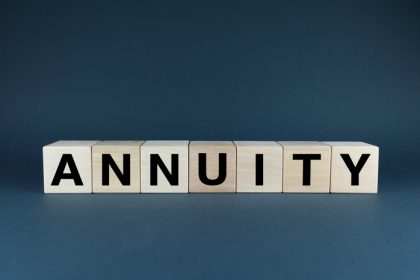Bonds and stocks each offer benefits, but they come with different levels of risk and return. A balanced mix can help build wealth while also reducing the impact of market swings, which is especially important as retirement approaches. The allocation for your 401(k) will depend on your age, risk tolerance, investment timeline and overall goals. A financial advisor can help you create a portfolio that fits your situation.
Bonds in a 401(k)
Bonds are often seen as the safer side of a retirement portfolio. They offer predictable income and lower volatility compared to stocks; however, bonds do come with limitations. Their long-term growth potential is generally lower, which may not be ideal for investors who need to outpace inflation.
Interest rate risk is another consideration. When interest rates rise, existing bond prices typically fall, which can affect the value of bond holdings in your 401(k). Investors should also be mindful of the types of bonds available in their 401(k) plan. Options might include government bonds, corporate bonds, or bond funds, each with varying levels of risk and return potential.
Stocks in a 401(k)
Stocks are often seen as the main driver of growth in a retirement portfolio. Holding stocks in your 401(k) lets you take advantage of possible price increases and, sometimes, dividend payments. Over time, stocks have usually delivered higher returns than bonds, making them a strong option for younger investors or anyone with many years until retirement.
One of the primary advantages of stocks is their ability to help your retirement savings grow faster than inflation. This growth potential can lead to a significantly larger nest egg over time, particularly when combined with the tax-deferred nature of a 401(k). Stocks also allow for broad diversification. You can choose domestic equities, international stocks, and investments across various sectors and industries.
That said, stocks carry higher risk than bonds. Market volatility can lead to short-term losses, which can be problematic for those approaching retirement.
Stocks vs. Bonds – Performance

When comparing stocks and bonds, the contrast between long-term growth potential and short-term protection becomes clear. Over extended periods, stocks have consistently outperformed bonds, making them the growth engine of most retirement portfolios. However, bonds provide stability and income, particularly valuable during market downturns.
According to data from the NYU Stern School of Business, from 1928 to 2024, the S&P 500 delivered an average annual return of approximately 11.79%. Meanwhile, 10-year U.S. Treasury bonds averaged around 4.79%.
While this difference in annual returns may seem modest, compounding magnifies the gap dramatically over time. A hypothetical $100 invested in the S&P 500 (with dividends reinvested) would be worth nearly $1 million today, whereas the same amount in 10-year Treasuries would have reached only about $7,159.
This stark contrast explains why financial advisors often recommend younger investors emphasize stocks in their portfolios. A longer time horizon means you can better weather the stock market, allowing growth to compound over decades. However, as retirement approaches, the focus typically shifts toward capital preservation. A single major downturn can significantly impact a retiree’s portfolio, especially when withdrawals are funding living expenses. This is where bonds play a crucial role.
Historically, bonds have acted as a buffer during turbulent markets. For example, in 2008, amid the global financial crisis, the S&P 500 plummeted nearly 37%, while 10-year U.S. Treasuries returned over 20%, shielding conservative investors from the full brunt of the stock market collapse. Bonds helped dampen portfolio losses for those with balanced allocations, while stock-heavy investment portfolios endured sharp volatility.
Asset Allocation of Stocks vs Bonds in a 401(k)
The safest bet for retirees is a diversified portfolio that includes both stocks and bonds. Asset allocation — the division of investments among different asset classes — is one of the most important decisions shaping your portfolio’s risk and return. Your ideal mix will evolve over time, reflecting changes in age, market conditions and personal risk tolerance.
A common guideline is to subtract your age from 110 to estimate the percentage of your portfolio that should be in stocks, with the remainder in bonds. For example, a 30-year-old might have 80% to 90% in stocks and 10% to 20% in bonds. By age 50, the allocation might shift to 60% stocks and 40% bonds, and by age 65, many investors move toward 40% stocks and 60% bonds to reduce volatility and preserve capital.
No allocation guarantees positive returns in every market. Stock-heavy portfolios offer the potential for long-term growth, but come with heightened risk. Meanwhile, bond-heavy portfolios provide stability, but may lag in growth, especially during bull markets.
Target-date funds, common in many 401(k) plans, adjust the stock-bond balance automatically as you approach retirement. However, even with these, periodic reviews are essential to ensure alignment with your risk tolerance and retirement goals.
Bottom Line

Balancing stocks and bonds in your 401(k) is not a one-size-fits-all decision. Stocks offer the potential for significant long-term growth, while bonds provide income and stability, especially as you approach retirement. Regularly reviewing and adjusting your asset allocation can help ensure that your retirement savings remain on track.
Retirement Planning Tips
- A financial advisor can help you analyze investments for your retirement portfolio. Finding a financial advisor doesn’t have to be hard. SmartAsset’s free tool matches you with vetted financial advisors who serve your area, and you can have a free introductory call with your advisor matches to decide which one you feel is right for you. If you’re ready to find an advisor who can help you achieve your financial goals, get started now.
- If you want to know how much you could pay in taxes for the sale on an investment, SmartAsset’s capital gains calculator can help you get an estimate.
Photo credit: ©iStock.com/Liubomyr Vorona, ©iStock.com/shapecharge, ©iStock.com/nortonrsx
Read the full article here
















